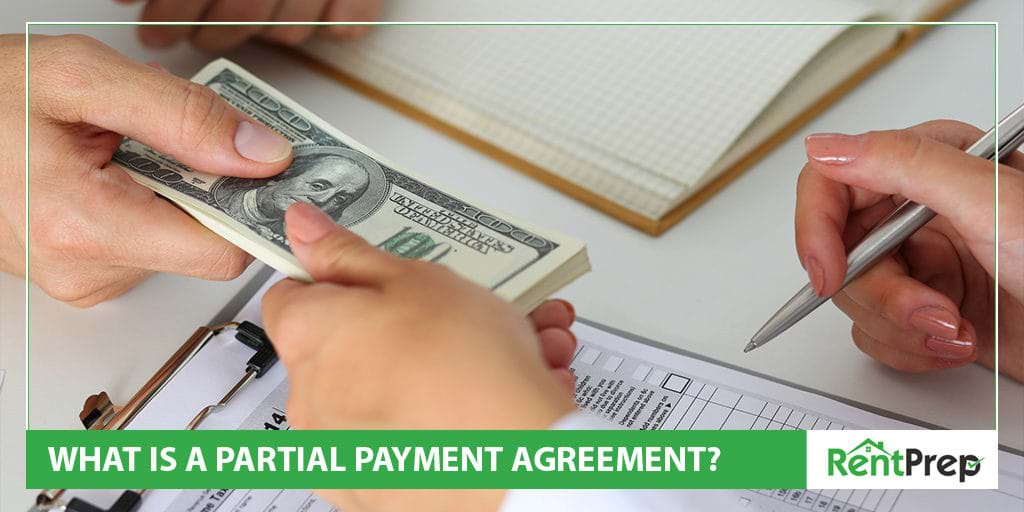
Every landlord has heard this statement before: “Never accept partial payments, or you won’t be able to get your property back or any money in court if you need to evict the tenant.” While this is a widely held belief, is it true that you can never accept partial payments?
The truth is more like this: you shouldn’t accept overdue rent if you plan to evict the tenant without any documentation, but you can accept overdue rent if you have the right plan in place.
This type of situation can be difficult to understand at first, so we’ll go into more depth today about how to do a partial payment agreement. Then, we’ll share our sample partial payment installment agreement.
A Table Of Contents For Partial Payment Installment Agreements
- What Are Partial Payments In The Rental World?
- Why Are Partial Payments Usually Viewed Negatively?
- All About Partial Payment Installment Agreements (Plus Sample)
- Don’t Forget These Tips
What Are Partial Payments In The Rental World?

When the phrase “partial payments” is used in the rental world, the exact meaning is going to depend on the situation that you are using it in. Sometimes, partial payments are small amounts of rent paid even when more money is due. At other times, partial payments are installments paid towards overdue rent.
Today, we’ll be talking about the latter type of partial payments. These partial payments are used whenever a landlord wants to collect late rent without evicting their tenant, and we’ll explain more about how to do that when we introduce our sample form below!
Why Are Partial Payments Usually Viewed Negatively?
Many landlords have been told that they should never accept any partial payments from tenants if it is late. While this is not always a solid piece of advice, there are reasons that partial payments have garnered a negative reputation.
In cases where you need to file for eviction, accepting a partial payment can push back the entire eviction process as you will have to start from the beginning with an eviction notice again. In a way, accepting a partial payment in that situation gives the tenant the right to stay at your property longer without paying the full amount.
And for that reason, many landlords don’t want to even consider accepting a partial payment! Still, partial payments are not always a bad thing.
The Positive Side Of Partial Payments
The type of partial payments that are we talking about today can also be called installments, and they are used whenever a tenant is ready and willing to pay back late rent. By setting up a partial payment installment agreement between you and the tenant, you can keep your property rented while also collected the money that you are owed.
Partial payments can be a good way to keep tenants that had some financial trouble in your property if you do not want to evict them while still ensuring that you will get paid. By setting up an official agreement, you have a guarantee which you can bring forward in court if you ever do have to move to evict the tenant in the future.
All About Partial Payment Installment Agreements (Plus Sample)
Let’s start off by answering the most basic question: What is a partial payment agreement?
A partial payment agreement is a legally binding document that lays out a plan through which a tenant can pay back overdue rent on a set installment schedule. For example, the plan might have them pay back $200 per month in addition to the rent they owe. The document ensures that you will get paid back, but allows the tenant to keep living there.
As we break down the specifics of our sample document, you’ll begin to understand more how this tool can be crafted and used:
| Partial Payment Agreement |
As we walk through the specific parts of the form, keep in mind how you would use this form in your own tricky late rent situations.
Identifying Information
Agreements like this one always need to start with all important identifying information. This includes the following:
- Date
- Property Address
- Tenant Information
While you know all of this information already, including it makes this official document as clear and understandable as possible. By reiterating the basics, you’re ensuring that everything included in the document is legal. Any chance of confusion is greatly lessened with just these few simple facts.
Monthly Rent
Next, you’ll want to include what the monthly rent for the property currently is. While both you and the tenant already know this as it is agreed upon in your rental agreement, adding it here helps to lay out the full payment situation so that both parties are sure of what will be paid monthly.
Owed Rent And Payment Plan
Now, it’s time to layout the amount owed and the plan for it to be paid back to you. First, include the entire amount of late rent that is owed to you. This might be as small as one month’s rent or as high as you allowed it to become, but the entire amount needs to be listed here.
Then, write out the details of the installment plan:
- Number of installments
- Monetary amount of each installment
- Due date of installment each month
By including those three details, you and the tenant will be on the same page about how much they need to pay. Be sure to mention that the installments owed must be paid in addition to the usual monthly rent. Each partial payment installment is an extra payment.
How To Pay

Next, your agreement should include all necessary information about how the tenant can make the installment payments. It is up to you to decide how to accept payment, but most states and municipalities encourage you to accept multiple forms of payment.
In our sample document, we include space for the following payment information:
- Cash, check, or cashier’s check
- Direct deposit information
- Delivery information
- Drop-off information
No matter what types of payment methods you decide to accept, you need to be sure that you give complete, thorough, and accurate details about how to pay here. If the tenant doesn’t know how to pay, you won’t be able to collect the money that you are owed.
Summary
Finally, you will want to add a disclaimer to the end of the agreement that reiterates that the original rental agreement terms are still in full effect. This document can be thought of as an addendum to the original lease. The terms here do not replace or change the original lease in any way.
Should the tenant fail to follow through on the terms of this partial rental payment agreement or the original rental agreement, you will have a right to move for eviction according to the terms of local law and your original agreement.
When To Use A Rental Partial Payment Agreement?
When is it in your best interest to set up this type of partial payment agreement? Many landlords never like to allow a tenant to continue to live at their property if they are not paid up in rent, and that is an understandable feeling. There are, however, some situations whenever setting up an installment payment plan can work out.
1. Hard-To-Rent Properties
If you have a property that is very difficult to find renters for, it can be in your best interest to make a last-ditch effort to keep paying tenants in the property as long as possible by setting up a partial payment plan.
2. Unexpected Expenses
If you have it on good authority that the tenant missed payments because of unexpected issues that are now remedied such as illness or another emergency, partial payment plans can be a great option. The tenant will be able to catch up on their payments, and you’ll be able to help them keep their home.
3. Court Ordered
Sometimes, eviction judges will require that you accept a payment plan and allow a tenant to continue to live at the property if it is the first time that they have had an eviction filing against them. In these cases, you’ll have to follow the court’s judgment.
4. Second Chances
If you are sure that you picked quality tenants and simply want to give them a second chance to prove themselves, setting up a payment agreement can be a less risky way to do that. While you may end up needing to file for eviction anyway, it’s not a bad way to allow the tenant extra time to catch up on payments.
It’s Up To You
Ultimately, it is usually your decision to decide whether or not you will accept an installment payment plan to collect late rent while the tenant stays on at your property. In many eviction cases, backpay takes months or years to be collected if the money is ever seen.
Avoiding eviction and setting up a payment plan that works for both parties can be a beneficial way to keep your profits safe without the stress or struggle of an eviction. These partial payment agreement terms won’t be right in every situation, but they could be right in yours!

